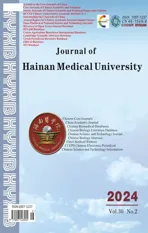Pueraria isoflavones inhibit XOD and GLUT9 to decrease uric acid production and promote uric acid excretion, respectively
2024-05-25LITongLIANGBaoyueLIUHanFANGShaotingZHANGMingjieLUOJingCHENPinnuoSONGJichiCHUXiaoHUANGChunxia
LI Tong, LIANG Bao-yue, LIU Han, FANG Shao-ting, ZHANG Ming-jie, LUO Jing, CHEN Pin-nuo, SONG Ji-chi, CHU Xiao, HUANG Chun-xia
Changsha Medical University, Changsha 410219, China
ARTICLE INFO
Article history:
Received 17 Sep 2023
Received in revised form 20 Nov 2023
Accepted 21 Dec 2023
Available online 28 Jan 2024
Keywords:
Kudzu root
Isoflavone
Hyperuricemia
Xanthine oxidase
Human glucose transporter 9
Inflammation
Reduce generation
Promote excretion
ABSTRACTObjective:To analyze the possible mechanism of Pueraria isoflavones inhibiting XOD and GLUT9 to reduce uric acid production and promote uric acid excretion.Methods:August 2021-April 2022, a total of forty SPF male Kunming mice were divided into the healthy group(carboxymethylcellulose sodium at a dose of 250 mg/kg), the model group (HUA mice were given carboxymethylcellulose sodium at a dose of 250 mg/kg), the low group (HUA mice were given pueraria isoflavone at a dose of 125 mg/kg), HUA mice were given pueraria isoflavones at a dose of 250 mg/kg once d frequency)and the high group (HUA mice were given pueraria isoflavones at a dose of 500 mg/kg once d frequency) dosage groups, with 8 mice in each group.The contents of uric acid (SUA), urea nitrogen (BUN) and creatinine (SCr) in serum and urine of each group were compared before and after intervention (30 d).Statistical differences of xanthine oxidase (XOD) and human glucose transporter 9(GLUT9), cy- clooxygenase-2(COX-2), tumor necrosis factor (TNF-α) and interleukin-1 (IL-1β) contents in renal tissues of each group after intervention (30 d) were compared.Results:After intervention, kidney inflammatory factors (COX-2, TNF-α and IL-1β) in the model group were compared.Blood and urine indexes (SUA, BUN, SCr); The contents of XOD and GLUT9 were higher than those of healthy group(P<0.05).Renal inflammatory cytokines (COX-2, TNF-α and IL-1β) in low, medium and high dose groups; Blood and urine indexes (SUA, BUN, SCr); The contents of XOD and GLUT9 were lower than those of model group, and there were low > medium >high dose groups, the comparison between the two groups had statistical significance(P< 0.05).After intervention, the contents of 3 indicators in blood or urine(COX-2, TNF-α and IL-1β)all decreased compared with before intervention, and the differences in intra-group comparison were statistically significant (P<0.05).Conclusion:Pueraria isoflavones can treat HUA mice by inhibiting the expression of XOD and GLUT9, and then play a role in reducing uric acid pro- duction and promoting uric acid excretion, as well as alleviating the degree of disease inflammation.
✉Corresponding author: HUANG Chun-xia, M.M., Associate Chief Physician.
E-mail: huangchunxia@csmu.edu.com.
Fund Project: National Innovation and Entrepreneurship Training Program for College Students (No.S202010823014); Hunan Provincial College Student Innovation Training Project, No.(2021)199(S202110823045)
杂志排行
Journal of Hainan Medical College的其它文章
- Advances in microRNA and inflammatory bowel disease and their related mechanisms
- Effect of honokiol regulating SIRT3 on chronic hypoxia-induced microglia and astrocyte polarization
- SLC6A8 promotes liver cancer cell proliferation by regulating mitochondrial autophagy through BNIP3L
- Clinical characteristics of patients with early-and late-onset optic neuromyelitis optica spectrum disease
- Distribution of gene polymorphisms associated with aspirin antiplatelet in the Han NSTEMI population
- Predictive value of systemic immunity index for sepsis in low-medium risk community-acquired pneumonia
